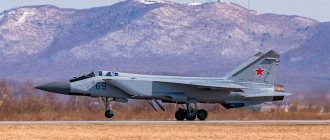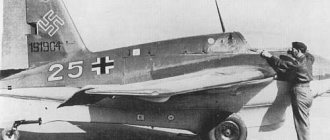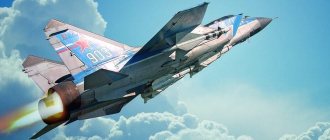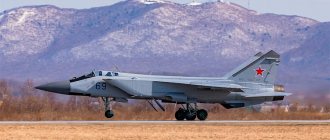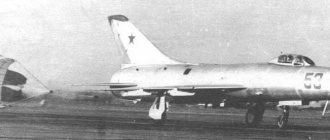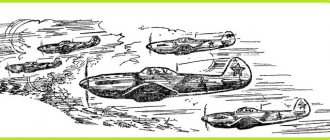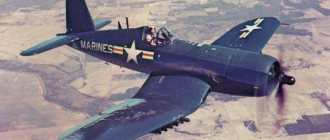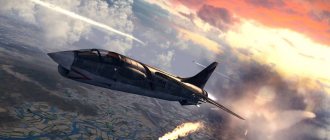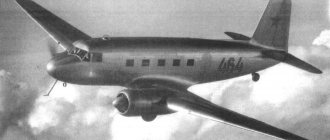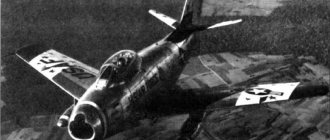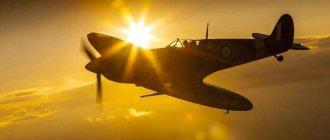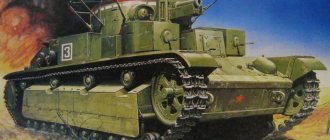The Tu-128, which according to NATO codification was called the “Fiddler,” is a two-seat loitering Soviet interceptor with a long range.
History of Tu-128
Beginning in the mid-50s, Soviet air defense units needed long-range interceptors that could provide extensive defense of the USSR's borders. It is for this purpose that the Design Bureau named after. Tupolev began work on the design of a new Tu-128 aircraft. Externally, it was similar to the Tu-22 bomber and could carry a powerful radar and air-to-air missiles on board. They designed an interceptor based on the Tu-102, which was first flown into the sky in 1959. The serial name of the Tu-102, which it received in 1963, is Tu-28P. The next deep modernization of the aircraft received the index Tu-128.
The Tu-128 interceptor implemented many technical ideas from the Tu-98 bomber, in particular the low-mounted wide swept wing, the placement of landing gear bars in the wing nacelles and the low-mounted stabilizer.
Tu-128 design
The power plant included a pair of AL-7F-2 turbojet engines, which were placed inside the fuselage. Unlike the basic Tu-22, the new interceptor was not equipped with an internal weapons bay. The weapons were fixed on the wing pylons, and the fuselage was used as huge fuel tanks. The Tu-28P prototype had a cockpit design that could accommodate two people, who sat one behind the other.
The Tu-102 carried a huge built-in radar, but the bulge of the bottom also contained test equipment. The Tu-28P aircraft had a large nose cone to control missile weapons, which were activated through the Smerch-100 thermal radar system. It has a target detection radius of 50 km, and a capture radius of within 40 km. Thanks to its good detection and acquisition of targets, the interceptor did not have to communicate with ground-based radars; it could independently carry out interceptions.
In the case of autonomous operations, only some data on the location of air targets was required. Therefore, it could be effectively used in regions difficult to reach for ground-based radar. During operation, it was often used together with the Tu-126 AWACS aircraft complex. The plane had practically no defensive weapons, electronic warfare systems, or radar warning systems, which were equipped with smaller interceptors designed by the Sukhoi Design Bureau.
The Tu-128 became an interceptor that had a large wing load, simple controls and poor visibility, high weight and modest maneuverability. The aircraft's mission was to intercept NATO strategic bombers, such as the B-52, rather than engage in combat with smaller, more maneuverable enemy aircraft.
The complex of communications and navigation equipment used on the Tu-128 was the same as that of long-range bombers. This made it possible for the interceptor to patrol in the harsh climatic conditions of the Far East and Far North. The efficient operation of the AL-7F-2 engines in various flight modes was ensured by air intakes with movable two-net cone bodies. The advanced takeoff and landing qualities of the Tu-128 at that time were based on the use of retractable slotted flaps, and during landing, in addition to them, a braking parachute and spoilers were also used.
Aviation and Time: Efim I. Gordon, Vladimir G. Rigmant / Moscow
The violinist who protected the sky
On July 9, 1961, the Moscow sky shook with the roar of dozens of new supersonic aircraft flying at low altitude. There was a traditional air parade in Tushino. Among the aircraft presented for the first time was a prototype of a supersonic long-range two-seat loitering interceptor. By that time, there were only two samples of this machine: an experimental one and the first production one. A series of complex developments and tests lay ahead. However, the country's leadership decided to publicly present it to the general public, proving to the whole world that the USSR had enough strength and resources not only for gigantic rocket and space programs, but also for the creation of combat aircraft for a wide variety of purposes. The parade was followed by enthusiastic press comments about the state and prospects of Soviet aviation. However, the real state of affairs was somewhat different. Aviation design bureaus refocused on creating rocket technology, many serial aircraft factories changed their profile, expanding the production of rockets and spacecraft. The military-industrial complex placed a strong emphasis on the “rocketization” side of its programs, devoting space to aircraft topics only where the creation of aircraft-missile systems was discussed. One of these lucky exceptions was the Tu-128 interceptor, which at that time was allowed to “take wing.”
Initiative of Marshal Savitsky
For the military-political leadership of the USSR, the creation of a highly effective air defense system capable of covering the giant country from any penetration with an “impenetrable umbrella” was one of the most important tasks throughout the entire post-war period. In the second half of the 50s. potential opponents of the Soviet Union received a new generation of aviation and missile systems capable of delivering nuclear strikes in a short time to almost all important military and economic centers of the country and its allies. This required response measures to be taken as quickly as possible. The first Soviet anti-aircraft missile systems S-25 and S-75, due to their limited range and low mobility, could protect airspace only in the area of large cities and military installations. At the same time, interceptor fighters armed with missiles could destroy enemy air attack weapons at a considerable distance from the borders. In this way, it was possible to cover vast areas over Siberia and the Far East, where the deployment of a large number of air defense systems was practically impossible. At that time, in the USSR, interceptors for air defense were created by equipping serial front-line fighters with airborne radars and air-to-air missiles or by developing new specially designed aircraft. The adoption in the mid-50s became very important. concepts of the aviation and missile complex. The fighter-interceptor was now considered as an integral part of a single system consisting of a carrier aircraft, air-to-air missiles, airborne radar detection and guidance equipment, as well as ground-based radio equipment. The first systems to enter service were those based on the MiG-17PFU and Yak-25K interceptors, equipped with four RS-1U (K-5) missiles.
Radio sight "Argon" (on the top of the keel) and aft gun mount of the aircraft "98"
Later, supersonic MiG-19PM and Su-9 armed with four RS-2US (K-5M) missiles were deployed throughout the country. This was followed by Su-11 and Yak-28 based complexes, each of which carried two R-8 missiles. But these complexes were quite effective at a distance of only a few hundred kilometers from protected objects. To fight an air enemy at a distance of more than a thousand kilometers, it was necessary to create a completely different type of interceptor fighter. The first attempt to create such an aircraft was made at the S.A. Lavochkin Design Bureau in the second half of the 50s. The 30-ton La-250 interceptor had an estimated flight duration at subsonic speed of over two hours and a maximum speed of up to 1,600 km/h. However, for a number of reasons, its testing dragged on for four years, which led to the cessation of work. The failure with the La-250K-15 complex put the air defense command in a difficult position. Therefore, even during the testing of the La-250, it drew attention to the potential possibility of using the Tupolev front-line bomber “98” as a fighter-interceptor. In 1957, the commander of air defense aviation, Marshal E.Ya. Savitsky, came to OKB-156 to A.N. Tupolev and proposed to create an interceptor similar to the “98” aircraft, but equipped with air-to-air missiles and powerful on-board radio equipment, providing their use. In a conversation with Savitsky, a number of questions were clarified, after which Tupolev instructed the head of the technical projects department, S.M. Yeger, to develop this idea in more detail.
Airplane "98"
At OKB-156, research on the subject of heavy supersonic aircraft began at the end of 1949. For two years, OKB-156, together with TsAGI, carried out a number of applied and theoretical works on the selection of the main weight and overall parameters of heavy supersonic aircraft of all types - from front-line bomber to intercontinental strategic missile carrier. First of all, the question arose about what the wing should be: swept or triangular with low aspect ratio. At the same time, the issue of the power structure of the wing was being worked out. To achieve high supersonic speeds, new turbojet engines with afterburner thrust of about 10,000 kgf were required.
Experienced supersonic bomber "98"
The use of such engines created a number of problems with the layout of the power plant, the air supply to the engines and ensuring their normal temperature conditions. High flight speeds required the introduction of irreversible hydraulic boosters into the aircraft control system in combination with various types of loaders and dampers. Issues related to the composition and layout of equipment, as well as weapons, had to be resolved in a new way. The number of crew members was reduced, and most functions were transferred to automatic control systems, the operation of which was complicated by increased temperature and vibration loads in supersonic and transonic flight modes. This reduced the reliability of many systems and the aircraft as a whole.
In mid-January 1953, Jaeger's department began the aerodynamic layout of a new supersonic aircraft. On May 17, 1954, these works were legalized by Resolution of the Council of Ministers of the USSR No. 683-301, according to which OKB-156 was instructed to develop, build and test the supersonic front-line bomber “98”. By this moment, his appearance in general terms had already been determined. In November, the production of working drawings began, and at the same time, plant No. 156 began building the first of two prototypes of the machine (the second was intended for statistical tests).
Neither the OKB nor TsAGI still had unity on the issue of choosing the aerodynamic shape of the wing. Two directions collided: V.V. Struminsky (swept wing of relatively high aspect ratio) and P.P. Krasilshchikov-R. Steinberg (thin triangular wing of low aspect ratio). The arguments, and most importantly, the authority of Struminsky turned out to be stronger, and for the “98” aircraft they chose a swept wing with a sweep angle of about 55′. Its design was determined in close cooperation between strength engineers from OKB and TsAGI. AM Cheremukhin, who dealt with Tupolev’s strength issues, organized the construction and testing of models of wing elements significantly ahead of the release of working drawings. It turned out to be quite difficult to solve the problem of the force interaction of the swept console caisson with the straight center section caisson. To more accurately study the distribution of loads of such a structure, strength scientists also used the full-scale modeling method.
In the course of the work, based on experimental data from TsAGI, they compiled a network of design characteristics of the “98” aircraft (speed, altitude and flight range) depending on wing geometry, take-off weight, etc. This made it possible to optimize a number of aerodynamic configuration parameters. Subsequently, these materials were repeatedly used in other developments of the OKB.
In the course of developing the technology for manufacturing wing and fuselage panels, the design bureau's designers, strength engineers and technologists encountered great difficulties. Due to the small relative thickness of the wing, the panels were unusually highly loaded, which for the first time required the use of skins up to 8-10 mm thick. Modeling and calculations carried out at the Design Bureau showed that to attach stringers to such a skin without significant overweight, rivets are needed, which the industry has not produced. Therefore, the OKB took a new path and proposed pressing the entire panel - the skin along with the stringers. Technologically, this turned out to be possible if the panel was pressed in the form of a pipe and then unfolded. One of the advantages of this design was the reduction in the labor intensity of assembly operations, because a large volume of riveting work was excluded. To prevent the stringers from coming off when unrolling the pipe, we decided to attach them to the outside of the pipe. When it became clear that such an unusual technology did not reduce the strength of the panel, it was accepted and introduced into the production of the 98 aircraft, and later the Tu-22.
On the “ninety-eighth”, for the first time in the practice of OKB-156, irreversible hydraulic boosters were introduced into all control channels (before that, Tupolev was very wary of still “raw” boosters). At the same time, spring loaders and various types of steering dampers appeared, which made it possible to obtain acceptable control. The power plant of the bomber consisted of two AL-7F engines from the A.M. Lyulka Design Bureau with a static thrust of 6500 kgf (9500 kgf in afterburner), located in the rear fuselage. Air was supplied to them through elongated air intakes that began behind the cabin. The main landing gear was attached to the beams of the bomb bay and was retracted back into special niches by the engines. At the same time, the four-wheeled cart rotated 90′ and occupied a horizontal position together with the stand. This solution made it possible to obtain an aerodynamically clean wing, but it worsened the stability of the car when driving on the runway, especially slippery ones. Especially for the “98” bomber, under the leadership of A.V. Nadashkevich and I.I. Toropov, a stern remote rifle installation with two AM-23 cannons was developed, the guidance of which was carried out using the PRS-1 “Argon” radar sight.
D.S. Markov was appointed lead designer for the “98” aircraft, and A. Zalessky was appointed lead production engineer. Construction of the prototype was completed in July 1955. The aircraft was transported to the flight test and development base (L I iD B) in Zhukovsky, where until February 1956. it stood without engines until the A.M. Lyulka Design Bureau provided two AL-7Fs from the first, not yet fully completed batch. Until June, ground testing of systems, engines, weapons was carried out, and equipment was also completed. On July 7, factory tests began. The vehicle was taken on its first flight by test pilot V. Kovalev and test navigator K. Malkhasyan.
The experimental bomber was tested until 1959. A maximum speed of 1238 km/h was achieved (according to the preliminary design it was 1365 km/h). The flight range with a normal combat load was 2440 km. The take-off length with a take-off weight of 39 tons in afterburner is -1160 m, and the run (with a braking parachute) is 865 m. The take-off and landing characteristics made it possible to operate the aircraft from the airfields where the Il-28 was based. Despite the good data, the “ninety-eighth” was not launched into production. The vehicle shared the fate of the S.V. Ilyushin Il-54 bomber. Since the mid-50s. The functions of front-line strike aviation began to be transferred to a new class of aircraft - fighter-bombers; in addition, the Il-28 still coped well with its tasks. On February 28, 1958, the Council of Ministers issued resolution No. 1013/482, which removed the issue of serial production of the bomber.
The “98” aircraft was presented to the American General A. Twiling in Kubinka in 1956. The aircraft was named Backfin by NATO code. In the West, they assumed that the bomber was created at the Yakovlev Design Bureau and designated it as the Yak-42. The composition of the power plant was also incorrectly determined (Western experts believed that it consisted of two AM-3 engines). But the tactical and technical characteristics given in print were quite close to the true ones.
First display of the Tu-128 at the air parade in Tushino, 1961.
In 1957, the 98 bomber took part in the preparations for the failed air parade in Tushino. At the rehearsal, he passed over the field of the Tushinsky airfield, accompanied by two Mikoyan Design Bureau E-5 fighters.
While the tests were underway, OKB-156 prepared designs for new attack aircraft based on the “ninety-eighth”, which were supposed to carry mixed versions of weapons - bomber and missile. The aircraft were supposed to be launched into series under the designation Tu-24. According to the first option (aircraft “98A”), a Tu-24 front-line bomber with two AL-7F-1 engines was supposed to reach speeds of up to 1800-2000 km/h. In the missile carrier version, it could carry one or three P-15A or P-15M missiles with a launch range of 60-70 km and was intended for attacks on aircraft carriers and naval groups of a potential enemy. In the bomber version, the maximum bomb load of the vehicle was 3.0 tons. With a normal bomb load of 1.5 tons, the aircraft at subsonic speed had an estimated flight range of about 2000 km, a ceiling of 17500-18000 m. Normal take-off weight did not exceed 30 tons. Overall The layout of the 98A corresponded to the original layout of the 98 bomber. According to the “98B” project, the Tu-24 was to be equipped with two AL-7F-2 or VD-15, or AL-9 engines. For this option, a new wing with an increased area and an all-rotating stabilizer were designed. The sighting station for the aft gun mount was moved from the top of the keel to its base, and the bomber radar was moved to the center of the fuselage. This project included the option of taking off the aircraft from the launch ramp using boosters.
The latest project on this topic was the “122” aircraft, on which the designers completely abandoned defensive weapons, and the number of crew members was reduced to two people (pilot and navigator). It was supposed to install AL-7F-2 engines. The main landing gear, unlike the original versions, was retracted into the wing nacelles according to the traditional Tupolev scheme - backwards with a turn. This project became a transition to Project 128, a supersonic loitering interceptor fighter.
The task is to intercept at long range
For almost a year, work on the topic of a long-range interceptor was carried out at OKB-156 almost on its own initiative. The development of the preliminary design of the aircraft and the study of the combat capabilities of the complex as a whole were led by the leading engineer for the aircraft and the complex, V. Babanov, together with the combat use brigade. General management was carried out by Jaeger. Almost all departments of the design bureau participated in the development of the preliminary design. Aerodynamicists A. Gunin, N. Bykovaya and others carried out a lot of work on choosing the optimal flight modes of an aircraft for combat use.
R-4 (K-80) missiles are the weapons of the Tu-128. A protective cap is placed on the radar homing head
After the technical proposal prepared in 1958, the topic was approved by the military command, and work continued on a “legal” basis. Initially, the Tu-28 fighter-interceptor with K-24 missiles was considered as part of the Tu-28-24 complex. In this project, the overall configuration of the aircraft was close to projects “98” and “122”. However, during the work, the appearance of the interceptor changed: the sweep of the leading edge of the wing root increased, and its trailing edge became straight. Subsequently, the contours of the carrier remained virtually unchanged.
On June 4, 1958, Resolution of the CPSU Central Committee and the USSR Council of Ministers No. 608-293 was issued, followed by No. 1013-482 of August 28 on the creation of the Tu-28-80 air defense missile system. In the same year, the corresponding orders were issued by the GKAT - State Committee on Aviation Technology (No. 211 of June 17 and No. 382 of September 20). According to these resolutions and orders, OKB-156 was supposed to create a long-range supersonic loitering interceptor Tu-28 with two AL-7F-2 engines designed by AMLyulka or with a VD-19 designed by OKB-36 V.A. Dobrynin (if they are ready). The OKB, headed by F. Volkov, was supposed to design and build the RP-S Smerch airborne radar, and the OKB M.R. Bisnovat
— K-80 air-to-air missiles with radar and thermal homing heads. According to the regulations, the interceptor should have been submitted for factory tests in the first quarter, and for state tests in the fourth quarter of 1960.
At the Tupolev Design Bureau, all work on the carrier aircraft and the complex was carried out under the code “128”. After the release of government resolutions, the topic “128” was headed by D.S. Markov. But due to his enormous workload on the Tu-22 and a number of civilian aircraft, in the summer of 1959, I.F. Nezval, one of the most capable organizers of the design and production of a number of Tu aircraft, was appointed chief designer of the long-range interceptor. The complexity of the work lay not only in the creation of the carrier itself, but also in organizing the interaction of various enterprises that participated in the creation of the complex.
In June 1959, the customer was presented with a preliminary design, developed taking into account the results of blowing models in wind tunnels, as well as other experimental and computational work carried out by OKB teams. The project clearly formulated the capabilities of the Tu-28-80 complex in the country's air defense system. To increase its combat effectiveness, two K-80 missiles were equipped with semi-active radar homing heads (for attacking from the front hemisphere), and the other two were equipped with thermal homing heads (for attacking from the rear hemisphere, as well as in conditions of radio interference).
External pylon on the first Tu-128 prototype
According to preliminary calculations, the probability of hitting a target when firing two missiles should have been 76-77%. A special feature of the complex was that in an air battle the carrier aircraft did not maneuver to reach the target's flight altitude, as was done in most other aviation interception complexes. The long range of the K-80 missiles and the ability of them to hit objects flying at significant altitudes allowed the carrier aircraft to fly at significantly lower altitudes. Thanks to this, it was possible to transfer a significant part of the maneuver from the interceptor to the missiles and calculate the aircraft for an operational overload of 2.0-2.5d, and the missile for an overload of 15d.
In this regard, during the interception process, the aircraft performed a vertical maneuver (“hill” with an angle of up to 20′), which made it possible to reduce the upward deflection angle of the Smerch radar antenna to 70′. Long ranges for detecting and tracking radar targets, as well as a significant missile launch range, made it possible to launch an attack from any angle.
Another feature of the complex was the large range of the carrier aircraft. This made it possible to extend the interception line to a distance of up to 1,500 km, preventing bombers or bombing aircraft from crossing the country’s border. In the waiting area for enemy air forces, the interceptor could patrol for 3-3.5 hours. Due to the long detection range of the on-board radar, the aircraft did not need to accurately target the target using a ground-based guidance system; it could intercept the target independently. During autonomous operations, only individual data on the position of air targets was required. This made it possible to use it in areas where there were no automated guidance systems.
The designers did a lot of work on the aerodynamic and structural layout of the interceptor, as a result of which it was possible to achieve good flight characteristics in supersonic and subsonic flight modes, during takeoff and landing. To ensure high supersonic flight speeds and long loitering time at speed M = 0.85, a wing with a sweep of 56º with profiles of small relative thickness and a fuselage made according to the “area rule” were used. This configuration of the aircraft ensured a sufficiently high aerodynamic quality at subsonic speeds (Kmax = 9.85) and an acceptable drag coefficient at supersonic speeds (Cx = 0.0365 at M = 1.5).
A crew of two was optimal for this class of aircraft. Their responsibilities were distributed as follows: - the pilot piloted the aircraft, guided the target according to commands from the ground system and the RP-S (Smerch) radar, and also launched missiles; — the navigator-operator carried out aircraft navigation throughout the flight, searching for the target using the RP-S station, identifying and capturing it, as well as radio communication with the base airfield.
The complex of navigation and communications equipment on the carrier aircraft was almost the same as on long-range bombers, which made it possible for the interceptor to patrol in the Far North and Far East. For efficient operation of the AL-7F-2 engines in all flight modes, the air intakes of the Tu-28 had movable double-shock central cone bodies. Good takeoff and landing characteristics of the aircraft were ensured by retractable slotted flaps; in addition, spoilers and a braking parachute were used during landing.
After the customer approved the preliminary design in August 1958, production of working drawings began, which were transferred to the pilot plant. In January 1960, a mock-up commission was held. She generally approved the design of the interceptor and the systems installed on it, but required some modifications. The main changes concerned equipment. The airframe components of the prototype launched into production had to be modified slightly.
Even during the design process of the interceptor, the aviation industry received orders for the supply of a number of target aircraft for testing the Tu-28-80 complex, in particular: the Il-28M radio-controlled target, manned and unmanned target versions based on the Yak-25RV high-altitude reconnaissance aircraft, and the issue of Tu-16M (M-16) targets and suspended target missiles based on KSR-2 (KRM) missiles.
Since OKB-156 was responsible not only for the carrier aircraft, but also for the entire complex, and its fate largely depended on its subcontractors, the Tupolev team worked closely with all enterprises and organizations involved in this work. F. Volkov’s team was faced with the task of creating an airborne radar with a detection range of 50 km and a target acquisition range of 30-40 km. In addition to restrictions on weight and dimensions, quite stringent requirements for noise immunity were put forward for the station, because aircraft of the potential enemy were equipped with various electronic warfare equipment.
Aircraft "98LL" at the so-called storage site LIiDB OKB A.N. Tupolev
Internal pylon of serial Tu-128
External pylon of Tu-128 late series
The first prototype of the Tu-128 during testing. Under the fuselage - KZA fairing
For the first time in the USSR, the M.R. Bisnovat Design Bureau created all-aspect air-to-air missiles designed to destroy maneuvering targets in a wide range of operating conditions. The speed of approach of the missile to the target could vary depending on the angle of attack in the range from 200 to 1600 m/s. In such a wide range, it was impossible to ensure a high probability of hitting a target without coordinating the parameters of the missile and radio fuse control system with the approach conditions. Such coordination was carried out based on information received from the carrier aircraft at the time of launch. During the design, it was possible to solve the problem of significantly increasing the maneuverability of the rocket: the maximum value of the lateral overload was increased to 21d thanks to a sharp decrease in the specific load on the wing and an increase in its power-to-weight ratio.
Homing of the K-80 was carried out using the proportional navigation method. For layout reasons, the rocket had a normal aerodynamic design. Triangular wings and trapezoidal rudders were arranged crosswise. The solid fuel rocket engine had a total thrust impulse at the ground of 24,500 kgf/s. The high-explosive fragmentation warhead weighing 53.5 kg had a radio fuse and a safety actuator. The K-80 ensured the destruction of air targets flying at speeds of up to 2000 km/h at altitudes of 8-21 km (with an elevation above the carrier aircraft of up to 8 km) and at ranges from 2 to 25 km. The mass of the rocket was 483 kg, length -5450 mm, fuselage diameter - 315 mm. For its suspension on the interceptor "128"
developed a special underwing launch device APU-128. Missiles with a thermal head were suspended on the inner wing pylons, with a radar head - on the outer ones.
Taking into account the complexity of testing and fine-tuning the Smerch radar, its connection with the aircraft and missiles, the general interaction of all elements of the complex, it was decided to test the station on the flying laboratories "98LL" and Tu-104LL, and the latter even carried out launches of experimental K-80 missiles at targets. The modification of the prototype "98" aircraft was carried out in 1959 by installing the "Smerch" radar in place of the navigator's cabin and some other changes. Because of its appearance, the car received the nickname “buryak” from developers and testers. Work on this laboratory was headed by one of Tupolev’s oldest associates, A.I. Putilov.
"Fiddler" takes the stage
Construction of the prototype aircraft at plant No. 156 continued during the first half of 1960. By mid-summer, the interceptor was ready, and on July 12 it was transported to LIiDB, where they completed the installation of equipment and tested the systems. The first prototype was somewhat different in appearance from the production vehicles: a large fairing with control and recording equipment (KZA) and two ventral ridges were installed under the fuselage to increase directional stability.
To conduct factory tests, a team was created headed by D. Kantor, V. Karpinsky became the leading test engineer, the flight crew was appointed as test pilot M.V. Kozlov and test navigator K.I. Malkhasyan. In addition, the best pilots and navigators of the flight test base were preparing to fly on the experimental interceptor “128”: S.T. Agapov, A.D. Bessonov, V.P. Borisov, V. Molchanov, A.N. Nikolaev, V. .Bazhenov, V.Kolosov. During the preparation, training flights were carried out on Su-9, Yak-27 interceptors and other aircraft similar in purpose to the “128”. The team testing the vehicle also included the crew of the Tu-104LL, on which the most important elements of the complex were tested, led by the leading flight test engineer of OKB-156 A. Gorokhov. Subsequently, this helped solve many problems associated with the operation of the radar and the complex as a whole. Elimination of identified deficiencies and failures was carried out by a team led by leading production engineer A. Zalessky.
The experienced interceptor "128" was transferred to factory tests on January 23, 1961. Taxiing began on February 27. Throughout the first half of March, the prototype rolled hundreds of kilometers around the LII airfield. On March 18, M. Kozlov and K. Mal-khasyan took the car on its first flight, which lasted 30 minutes. On March 21, after the second flight, one of the engines was replaced. On the seventh flight, test pilot A. Bessonov joined the tests. The interceptor's behavior in the air and its takeoff and landing properties were tested on an experimental vehicle. On April 20, on the eighth flight, the aircraft at an altitude of 11,000 m reached a speed corresponding to the number M = 0.98. On April 24, the experimental “128” reached a speed of M = 1.06.
On June 23, on the 20th flight, training began before the traditional parade in Tushino. The demonstration of the vehicle with two mock-ups of K-80 missiles during the aviation festival was successful. This was the 31st flight of the experienced interceptor. Soviet newspapers called the plane “supersonic and multi-purpose.” Western commentators and experts unanimously accepted the KZA radome as a multifunctional radar. However, the appearance of the suspended shells did not allow any doubt about their purpose, and in NATO the vehicle received the “fighter” designation “Fiddler” (“Fiddler”).
The first prototype of the Tu-128
The second aircraft of the second series undergoing state tests. Under the wing - mock-ups of K-80 missiles
After finishing the factory, the prototype participated in state tests. The KZA fairing and ventral ridges were removed from it, and external underwing pylons were installed. In 1967, an experienced interceptor was tested on the LII dirt strip. In addition, the landing mode with the flaps not extended was studied on the aircraft, and high-altitude equipment and the VMSK-2 rescue suit were also tested. This machine is currently on display at the Air Force Museum in Monino.
From the end of 1959, in parallel with the construction of the prototype aircraft, without waiting for the results of flight tests, the construction of serial interceptors (product “I”) began at the Voronezh Aviation Plant (VAZ) No. 64. Four aircraft were put into production at once. Construction of the first production vehicle (No. 0101) was completed at the beginning of 1961. Taxiing began at the end of April, and on May 13, test pilot Voblikov made the first 30-minute flight on it. On June 10, on the sixth flight, the aircraft was transported to Zhukovsky, where from June 17 M.V. Kozlov, A.D. Bessonov and other pilots began performing regular test flights on it. From the beginning of July, to be on the safe side, they also began preparing it for the parade. The serial interceptor constantly accompanied the prototype during training. At the parade, however, only the prototype was shown, although the production one was also in the air.
During factory testing, the tasks became more complicated, and not all flights went smoothly. Thus, due to poor performance of the brakes of the main landing gear wheels, there were cases of destruction of the brake rods. The chassis legs also folded during the run, but the reason for this was not immediately found. Only after repeated cases of folding was it established that it was due to a defect in the collet lock of the strut. After modifications, the chassis began to function normally. During the flights, a lack of speed was also revealed. It was significantly increased by replacing the wing tips with sharper ones. In order to increase the stability of the interceptor, the fairings between the wing and fuselage were changed, and a number of other, smaller modifications were also made. The introduction of these changes caused large interruptions in flights and required them to be repeated, which affected the pace of factory testing, which continued throughout 1961.
Meanwhile, serial Tu-28s continued to roll off the stocks of plant No. 64. On August 16, 1961, the first aircraft of the 2nd series (No. 0201) took part in tests in Zhukovsky, on March 13, 1962 - the second aircraft of the 2nd series (No. 0202), on August 10 - the first aircraft of the 3rd series (No. 0301), in May 1963 - the first aircraft of the 4th series (No. 0401), in October - the second aircraft of the 3rd series (No. 0302). All changes and improvements were promptly taken into account in mass production. Already on plane No. 0301, the location of the radio-electronic equipment units was changed and the anti-surge doors were moved to the middle part of the fuselage. The middle part of the wing, the pylons with the APU-128 and many other elements of the aircraft were also modified.
On March 20, 1962, joint state tests of the interceptor began. Military test pilots N. Korovushkin and Yu. Rogachev, as well as navigator-operator N. Mozgovoy, arrived from the Air Force Research Institute in Zhukovsky. Together with OKB and MAP pilots, they performed a number of test flights. Five aircraft took part in these tests at various times: the first prototype, serial No. 0201, No. 0202, No. 0301 and No. 0401. In one of the flights, the interceptor, piloted by Yu. Rogachev and N. Mozgov, at an altitude of 11,800 m lost stability and began to fall randomly. Only thanks to the exceptional courage, composure and skill of the pilot at an altitude of 2000 m was it possible to take the car into horizontal flight and land it safely at the airfield. Throughout the fall, Rogachev transmitted information to the command punya about the behavior of the interceptor and about all his actions. For this flight the crew was awarded orders. After analyzing the KZA records, the designers made the necessary modifications to the aircraft to improve stability and controllability characteristics.
At the LII airfield, only part of the joint state tests of the Tu-28 and testing of the functionality of the complex were carried out. The other part of the program, which made it possible to evaluate the combat qualities of the complex, was carried out at the base of the Air Force Research Institute in Vladimirovka (Akhtubinsk). Initially, three aircraft took part in the flights, then two more joined them. Only the first production interceptor remained at the flight base in Zhukovsky, on which test pilot A.D. Bessonov and test navigator V. Bazhenov conducted a full cycle of tests of the power plant.
Together with the interceptors, OKB-156 test pilots M.V. Kozlov, S.T. Agapov, navigators-operators K.I. Malkhasyan, V. Kolosov, as well as D. Kantor’s team went to the south of the country. Hundreds of specialists from various enterprises and organizations were involved in work on the Tu-28 in Akhtubinsk (over 150 people participated from the Design Bureau and LIiDB alone). To manage the tests, a State Commission was created under the chairmanship of Marshal Savitsky. At this stage, military test pilots Yu. Rogachev, I. Lesnikov, E. Knyazev, G. Beregovoy, I. Dovbysh, test navigators N. Mozgovoy, V. Malygin, G. Mitrofanov and A. Khalizov flew on the interceptors . Taking into account the comments received, OKB-156 and its associates continued to fine-tune the aircraft and weapons.
The Tu-28 had a wide range of speeds: from 1910 km/h without missiles (1665 km/h with four missiles) to a landing speed of 280 km/h. At the same time, at low flight speeds, especially with the flaps extended, the aircraft had an increased roll response to rudder deflection, and at supersonic speed the response changed to the opposite. At subsonic speeds, especially at high speed pressures, the interceptor's margin of longitudinal static stability was insufficient. The missile suspension led to a further decrease in this margin at subsonic levels and to a decrease in track and lateral stability at M
Armament of Tu-128
The aircraft's armament included four R-4/K-80 air-to-air missiles developed by the Bisnovat Design Bureau. Typically these were two R-4R missiles, which had semi-active radar guidance and were fixed on external pylons, as well as two R-4T missiles, which were placed on internal pylons and had infrared guidance. The aircraft's armament was modernized in the 60s; it was equipped with R-4TM and R-4RM missiles.
The military use of the Tu-128 provided for several options. One of them involved identifying targets, and targeting the interceptor was carried out using ground stations and Tu-126 AWACS aircraft. Interacting with this complex, the Tu-128 could operate in a semi-autonomous mode. From the reconnaissance officer, the navigator operator received the course and composition of the target; further search by the interceptor was carried out independently.
On December 12, 1963, the USSR Ministry of Defense assigned the name of the aviation missile interception complex, which included:
- Tu-128 aircraft;
- R-4T and R-4R air-to-air missiles;
- Radar RP-S "Smerch".
Serial production of the Tu-128 aircraft lasted until 1970. Over the entire period, 188 interceptors were released. In 1971, 10 pilot training machines were created, four of which were converted from fighter aircraft. This modification was named Tu-128UT. In its design, an additional front cabin appeared in place of the radar. Further projects of the Tupolev bureau with the names Tu-138 and Tu-148 were not further developed.
Background [edit]
In the 1950s, the Soviet Union sought a means of defense against nuclear American bombers that could penetrate its borders (especially its long and vulnerable northern border) by flying from northern Soviet bases such as Talagi Airport and Savathia Air Base. [4] [5] [6] Modern interceptors, even the Yakovlev Yak-28P, could only cover a radius of a few hundred kilometers; [1][7][8] Recently developed surface-to-air missiles had an even shorter range [1] (the standard Soviet S-75 Dvina air defense missile system has a range of 45 km (28 mi)). Taking both into account, the sheer quantity required to protect a 5,000 km air front was economically impossible to maintain. This gave the Soviet Union the ability to provide modern air defense only in selected high-value areas. [8] The PVO decided to cover the entire area, but with looser protection. In 1955, he demanded the creation of an interceptor to protect a large area, which could be achieved with the help of sparse air bases. The PVO requirement required a supersonic aircraft with huge fuel tanks for good patrol time and long range, a capable radar and the most powerful air-to-air missiles possible. The first attempt, although unsuccessful, was the 30-ton prototype Lavochkin La-250 [8], the last of the Lavochkin Design Bureau aircraft.
Tu-128 crew
For this class of aircraft, a crew of two was most suitable. Crew responsibilities:
- The pilot was responsible for piloting the aircraft, aiming at the target based on commands from the onboard RP-S radar, and launching missiles.
- The navigator-operator was responsible for aircraft navigation throughout the flight, searched for air targets using an on-board radar, performed their recognition, acquisition, and was in radio contact with the base airfield.
Before the advent of the Tu-128 aircraft, fighter aircraft rarely carried a navigator-operator on board as part of the crew. But this model showed the effectiveness of high-level teamwork. Part of the navigation work fell on the shoulders of a specialist, while the pilot could concentrate on the main tasks: intercepting and hitting the target. The work became especially effective after honing the technology for hitting aircraft in the forward hemisphere. Thus, it was possible to make targeted hits, located at altitudes 3.5-4 km below the target, which was safer than shooting at the same level.
Tu-128 characteristics:
| Modification | Tu-128 |
| Wingspan, m | 17.53 |
| Aircraft length, m | 30.06 |
| Aircraft height, m | 7.15 |
| Wing area, m2 | 96.94 |
| Weight, kg | |
| empty | 24500 |
| normal takeoff | 40000 |
| maximum takeoff | 43700 |
| Internal fuel, kg | 1300 |
| Engines | 2 TRD Saturn (Lyulka) AL-7F2 |
| Thrust, kgf | 2 x 10100 |
| Maximum speed, km/h | |
| with UR | 1655 |
| without UR | 1910 |
| Practical flight range, km | 2565 |
| Practical ceiling, m | 15600 |
| Crew, people | 2 |
| Weapons: | 2 R-4RM and 2 R-4TM air-to-air missiles |
Tupolev Tu-128. Gallery.
Options [edit]
Tupolev Tu-128UT
Prototype Tu-28 ('Fiddler-A') Development aircraft, built alone.
OKB designation - 128
.
[1] [2] [3] In the West, the Fiddler-A
was used for all aircraft with two ventral fins [2] - these included the prototype and several initial production aircraft (possibly two [1] aircraft).
Tu-128 (also known as Tu-28; "Fiddler-B") Main version, first entered service in 1964[1] (or 1966[2][8] - sources differ). The military designation was at first Tu-28
,[2][8] but the existing aircraft were renamed in 1963.[1][11] The entire weapon system (aircraft, radar, missiles) was designated
Tu-128S-4
.
[1] [2] Western sources, but not Soviet ones, often mention a more precise designation for this version [3] [7] [9] as Tu-28P
or
Tu-128P
.
Tu-128UT (also known as Tu-28UT) Training version with an additional cabin in front of the regular one instead of a radar. ten built and four converted from standard interceptors. [1] [11] Tu-128M Modernization in 1979 of almost all [1] existing aircraft for better interception at low altitudes. Development began in 1970. [2] The engines and airframe remained unchanged. [1] The full designation of the entire weapon system is Tu-128S-4M
.
[1] [2] [11] It contained a new RP-SM Smerch-M
and a new missile system: R-4RM plus R-4TM. [1] [11]
Abandoned[edit]
Tu-28A New building, abandoned. [1] [11] Tu-28-80 Development designation, abandoned. [1] [11] Tu-28-100 Development designation, abandoned. [1] [11] Tu-138 New building, abandoned. [1] [11] Tu-148 New development, variable geometry wings, abandoned. [1] [11]
See also[edit]
| Wikimedia Commons has media related to Tupolev Tu-128 . |
- North American A-5 Vigilante [12]
- Boeing B-47 Stratojet
- Boeing B-52 Stratofortress
- Convair B-58 Hustler
Related development
- Tupolev Tu-98
- Tupolev Tu-22
Aircraft of comparable role, configuration and era
- Avro CF-105 Arrow
- Convair F-106 Delta Dart
- Lavochkin La-250
- McDonnell F-101B Voodoo
- North American Rapier XF-108
Related Lists
- List of fighters
- List of military aviation of the Soviet Union and CIS
Notes[edit]
- ^ab The Tu-128 was the largest fighter, assuming the definition of "fighter" includes an interceptor aircraft. The Tu-128 was not intended for fighter-fighter combat (i.e., fighting for air superiority). For an even heavier interceptor design that did not enter service, see Lockheed YF-12.
- The geographical distance between Murmansk and Anadyr is 4911 km.
- ↑
For example, in 1972, just six air bases provided sole interceptor cover for almost half of the interior of the Soviet Union. Most of the Tu-128 forces were deployed at these bases. [2]: 140 [7]: 259–262 - ↑
Some sources refer to the radar as RP-5 instead of RP-S, which may be an error.
